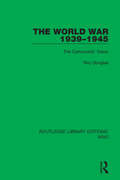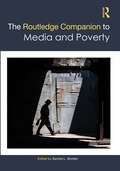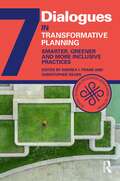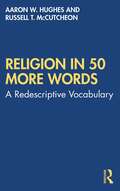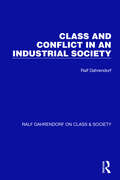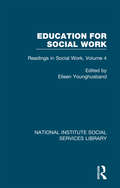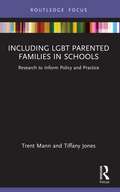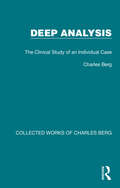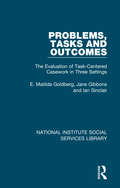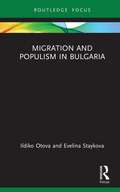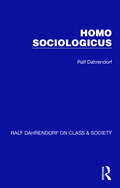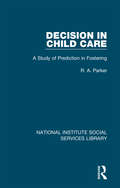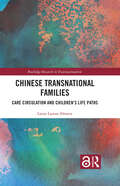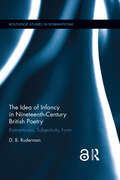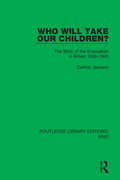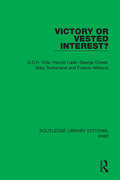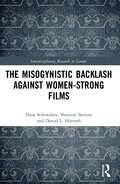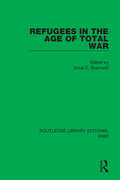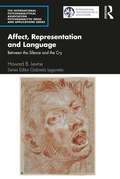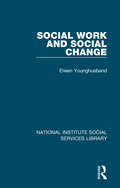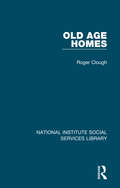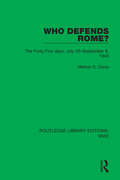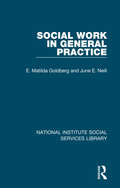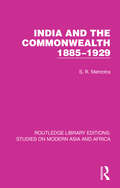Special Collections
Benetech’s Global Certified Accessible Titles
Description: Benetech’s GCA program is the first independent third-party EPUB certification to verify ebook accessibility. By creating content that is born accessible, publishers can meet the needs of all readers. Learn more: https://bornaccessible.benetech.org/
- Table View
- List View
The World War 1939–1945
by Roy DouglasThis new approach to the history of the Second World War, first published in 1990, examines the events of this period through the cartoons of the day. Roy Douglas explains the messages behind the humour and reveals that the perception of war differed radically from country to country. This collection highlights the importance of the media in this global war. ‘An authoritative narrative about what inspired the artists to take to their pens and papers… By putting it all into perspective, the poignancy, and often the brilliance of the political cartoonist is shown to the reader… Douglas’s historical narrative adds to the enjoyment.’ West Coast Review of Books ‘Douglas’s valuable book uses the political cartoon as historical mirror… The book is very important for its attempt to correlate visual media with national policy at a crucial period in recent history.’ Choice
The Routledge Companion to Media and Poverty
by Sandra L. BordenComprehensive and interdisciplinary, this collection explores the complex, and often problematic, ways in which the news media shapes perceptions of poverty. Editor Sandra L. Borden and a diverse collection of scholars and journalists question exactly how the news media can reinforce (or undermine) poverty and privilege. This book is divided into five parts that examine philosophical principles for reporting on poverty, the history and nature of poverty coverage, problematic representations of people experiencing poverty, poverty coverage as part of reporting on public policy and positive possibilities for poverty coverage. Each section provides an introduction to the topic, as well as a broad selection of essays illuminating key issues and a Q&A with a relevant journalist. Topics covered include news coverage of corporate philanthropy, structural bias in reporting, representations of the working poor, the moral demands of vulnerability and agency, community empowerment and citizen media. The book’s broad focus considers media and poverty at both the local and global levels with contributors from 16 countries. This is an ideal reference for students and scholars of media, communication and journalism who are studying topics involving the media and social justice, as well as journalists, activists and policy makers working in these areas.
Transformative Planning
by Andrea I. FrankThe Dialogues in Urban and Regional Planning series offers a selection of some of the best scholarship in urban and regional planning from around the world with internationally recognized authors taking up urgent and salient issues from theory, to education for and practice of planning. This 7th volume features contributions on the theme of Transformative Planning: Smarter, Greener and More Inclusive Practices. It includes chapters from leading planning scholars and practitioners who critically examine how transformative planning practices seek to reduce inequalities, promote sustained, inclusive and sustainable economic growth, achieve gender equality, improve human health and well-being, foster resilience of urban communities and protect the environment and thereby change urban planning paradigms. Several case studies of emerging transformative planning interventions illustrate practical ways forward. Transformative Planning offers provocative insights into the global planning community’s struggle and contribution to tackle the major challenges to society in the 21st century. It will be of use for advanced undergraduate and graduate courses in the wide-ranging fields encompassed by urban studies, sustainability studies, and urban and regional planning. The Dialogues in Urban and Regional Planning (DURP) series is published in association with the Global Planning Education Association Network (GPEAN) and its member national and transnational planning schools associations.
Religion in 50 More Words
by Aaron W. Hughes and Russell T. McCutcheonReligion in 50 More Words: A Redescriptive Vocabulary provides a succinct historical, social, and political examination of some of the key words used in the modern study of religion. Differing from the first volume’s more theoretical focus, this volume analyzes more common first order descriptive terms that are used throughout the field, inviting readers to theorize their traditional vocabulary. Topics covered include: • Atheism/Theism • Conversion • Cult • Evil • Fundamentalism • Idol • Magic • Pilgrimage • Ritual • Sacrifice Religion in 50 More Words submits such terms to a critical interrogation and subsequent redescription. This paves the way for a collective and more critical reframing of the field. The volume, along with Religion in 50 Words, provides an indispensable resource for students and academics working in the field of religious studies and cognate disciplines.
Class and Conflict in an Industrial Society
by Ralf DahrendorfOriginally published in England in 1959, this book evolves a new theory of conflict in industrial society. By way of illustrating and testing this theory, the book provides detailed analyses of various social phenomena. The author carries out a full critique of Marx in the light of history and modern sociology and discusses the theories of class-conflict of James Burnham, Fritz Croner and Karl Renner.
Education for Social Work
by Eileen YounghusbandSome outstanding contributions to a better understanding of the issues of education for social work have been brought together in this volume, originally published in 1968. Because of the wide relevance of the subject these articles should be valuable not only to social work educators and field supervisors in many different parts of the world, but to others concerned with professional education. Today it can be enjoyed in its historical context.
Including LGBT Parented Families in Schools
by Tiffany Jones and Trent MannThis book explores the experiences of LGBTQ+ parented families in school communities and provides a voice for this overlooked group who are becoming an increasingly common form of family diversity in school communities. Approaching the topic from a strength-based psychological perspective, the book presents LGBTQ+ parents’ suggestions for school improvements and supportive structures and provides empirical evidence to inform future LGBTQ+ inclusive educational policy. Research based yet practically focused, it will be a valuable resource for researchers, students and education professionals alike.
Deep Analysis
by Charles BergFirst published in 1947, with a second edition in 1950, the original blurb reads: 'This is an illuminating description of a complete Freudian analysis of a single case. From the first interview to the last the reader’s attention is engrossed with the almost-normal personality of the individual who is being analysed. We see his thoughts, philosophy, and emotions gradually unfolding under the application of analytical technique (lightly explained in the second chapter), until – and this is where the book is such a tremendous advance upon the psychological novel – the very springs and mechanisms of his psychic pattern and emotional structure are abundantly and lucidly revealed. We see and understand the hidden depths of the nature of the human mind, and obtain introductory insight not only into normal mental functioning, but into almost all its psychopathic aberrations including frigidity, impotence, love, hate, hysteria, obsessions, and even paranoia and schizophrenia – all in minor degrees an integral part of normality. In spite of this the book is light reading and, though particularly instructive to doctor and professional psychologist, understandable to the average intelligent layman.' This book is a re-issue originally published in 1950. The language used is a reflection of its era and no offence is meant by the Publishers to any reader by this re-publication.
Problems, Tasks and Outcomes
by Ian Sinclair and E. Matilda Goldberg and Jane GibbonsIn the 1980s, although most social workers organised their time and described their work in terms of cases, research studies had cast serious doubts on the efficacy of working in this way. As a result, there had been growing anxiety about what social workers do, what they ought to do, and the training they needed. Task-centred casework was an approach to social work which proposed a solution to some aspects of this dilemma. Growing out of the surprising results of an American research study, it broke free from the traditional psycho-analytic approach to casework. It aimed at clarity of purpose, a concentration on the clients’ perceptions of the problems, openness about clients’ and helpers’ intentions and agreement about what is to be done and achieved within a specified time. Originally published in 1985, this book brings together three British studies that accompanied, and in some respects pioneered, the introduction of task-centred casework into the United Kingdom. The studies describe and evaluate task-centred casework with social services department clients, with young people on probation, and with men and women referred to hospital after poisoning themselves. The research suggests what task-centred casework can and cannot achieve, describes how clients experience it and seeks to define the skills it requires. The studies also provide some reasons why many previous studies of social work have failed to find evidence for social work effectiveness. The book uses much case material to illustrate methods of task-centred casework and its outcomes as seen by clients, social workers, and an independent outsider. It should still be of interest to social workers, teachers of social work, and social work students. More generally, it will be welcomed by all those who are interested in building social work on a surer basis than anecdote and fashion.
Migration and Populism in Bulgaria
by Ildiko Otova and Evelina StaykovaFocusing on Bulgaria, this book addresses the key issues of migration and populism, which have grown to become dominant topics of debate within Europe and across the world over the last decade. Ildiko Otova and Evelina Staykova trace the history of migration and populist discourses within Bulgaria from 1989 until the present day. The authors analyse how a lack of clear and coherent migration policies on migration over the years left Bulgaria unprepared for the 2015 European migrant crisis, thus leaving the door open for populist ideology to help shape public perceptions and narratives of migration as a menace and burden to society. Far from being confined to the extreme fringes of the political spectrum, Otova and Staykova reveal how populism has increasingly been co-opted by mainstream parties. This shift to the middle ground has led to what they claim to be a ‘normalisation’ in populist rhetoric, giving legitimacy to attitudes towards migration as a threat to society, which they argue, in turn, renders constructive policymaking far more difficult. Adopting an interdisciplinary approach, this book is an important tool for postgraduate students and researchers of Political Sciences, Migration Studies, European Studies and European History, as well as practitioners working in the field of international migration and asylum.
Homo Sociologicus
by Ralf DahrendorfFirst published in English as part of the Essays in the Theory of Society, this volume reissues the stand-alone Homo Sociologicus for which the author wrote a new introduction when it was originally published in 1973. The controversial book deals with the history, significance and limits of the category of social role and discusses the dilemma posed by homo sociologicus. The author shows that for society and sociology, socialization invariably means depersonalization, the yielding up of man’s absolute individuality and liberty to the constraint and generality of social roles. This volume includes the essay, Sociology and Human Nature, written as a postscript to Homo Sociologicus.
Decision in Child Care
by R. A. ParkerResponsible decisions are continually being made in social work. In particular the decision to place a child in a foster home can have far-reaching consequences for their welfare and it is vital that we make the best possible choice on their behalf. Although in the 1960s thousands of children were boarded out every year no systematic attempt had yet been made to summarize this experience as a guide for practice. Thus important decisions lacked the help which past experience could provide. Originally published in 1966, this study assembled the past experience of foster care in one area, analysed it and presented it in such a way that predictions could be made of the outcome of a potential placement. At the time it offered an important contribution to the task of providing the best possible care for children separated from their own families. Today it can be read in its historical context.
Chinese Transnational Families
by Laura Lamas-AbrairaThe research presented in this book explores care and its circulation in Chinese transnational families that are split between China and Spain, and the paths these families’ children have taken through their lives so far: from their early years to their current position as young adults, with care, in its multiple dimensions and timescales – past, present and future – as the unifying thread. In doing so, it provides a contribution to the emerging body of research about care and transnational families and it posits the need to question hegemonic models of family, childhood and care, and to give voice and visibility to other actors, moving beyond the adult-centred perspective that dominates migration research. The ethnographic approach together with the focus on the day-to-day lives of these families, in which care is the core concept, as it permeates people’s lives and traverses society generationally, makes this book appealing to both scholars and general public.
The Idea of Infancy in Nineteenth-Century British Poetry
by D.B. RudermanThis book radically refigures the conceptual and formal significance of childhood in nineteenth-century English poetry. By theorizing infancy as a poetics as well as a space of continual beginning, Ruderman shows how it allowed poets access to inchoate, uncanny, and mutable forms of subjectivity and art. While recent historicist studies have documented the "freshness of experience" childhood confers on 19th-century poetry and culture, this book draws on new formalist and psychoanalytic perspectives to rethink familiar concepts such as immortality, the sublime, and the death drive as well as forms and genres such as the pastoral, the ode, and the ballad. Ruderman establishes that infancy emerges as a unique structure of feeling simultaneously with new theories of lyric poetry at the end of the eighteenth century. He then explores the intertwining of poetic experimentation and infancy in Wordsworth, Anna Barbauld, Blake, Coleridge, Erasmus Darwin, Sara Coleridge, Shelley, Matthew Arnold, Tennyson, and Augusta Webster. Each chapter addresses and analyzes a specific moment in a writers’ work, moments of tenderness or mourning, birth or death, physical or mental illness, when infancy is analogized, eulogized, or theorized. Moving between canonical and archival materials, and combining textual and inter-textual reading, metrical and prosodic analysis, and post-Freudian psychoanalytic theory, the book shows how poetic engagements with infancy anticipate psychoanalytic and phenomenological (i.e. modern) ways of being in the world. Ultimately, Ruderman suggests that it is not so much that we return to infancy as that infancy returns (obsessively, compulsively) in us. This book shows how by tracking changing attitudes towards the idea of infancy, one might also map the emotional, political, and aesthetic terrain of nineteenth-century culture. It will be of interest to scholars in the areas of British romanticism and Victorianism, as well as 19th-century American literature and culture, histories of childhood, and representations of the child from art historical, cultural studies, and literary perspectives. "D. B. Ruderman’s The Idea of Infancy in Nineteenth-Century British Poetry: Romanticism, Subjectivity, Form is an interesting contribution to this field, and it manages to bring a new perspective to our understanding of Romantic-era and Victorian representations of infancy and childhood. …a supremely exciting book that will be a key work for generations of readers of nineteenth-century poetry." Isobel Armstrong, Birkbeck, University of London Victorian Studies (59.4)
Who Will Take Our Children?
by Carlton JacksonThis book, first published in 1985, is a scholarly examination of the of the British wartime evacuation of 4 million people, mostly children, from the cities to the countryside – and how it affected social life during the war years. It uses hitherto unpublished material from the collections of the Children’s Overseas Reception Board and the Mass Observation Archive.
Victory or Vested Interest?
by George Orwell and Harold Laski and G.D.H. Cole and Mary Sutherland and Francis WilliamsThis book, first published in 1942, covers the whole field of wartime life and organization. Is the private ownership and control of industry holding up production? Are the burdens of war being shared equally by the whole community? How can individual liberty be reconciled with maximum efficiency? Are women taking their rightful share in the national effort? Does our literature and art reflect the spirit of an aroused and determined people? Have we a message which will win the oppressed peoples of Europe to our side? These questions are frankly discussed and positive suggestions are made.
The Meaning of the Twentieth Century
by Kenneth BouldingOriginally published in 1965 and written by a noted economist and leader in the field of conflict resolution, this book traces the forces which have brought the 20th century ‘post-civilisation’ into being: the ever-increasing power of science and the scientific attitude, the global communication network, the high efficiency of industrial societies. New conditions pointed to a life of ease but also enormous problems. The book discusses how though our technical resources have become immense, social and psychological conflicts remain. The author’s training in psychology and economics combines with a deep sense of history to create a book which is as relevant now as when it was first published.
The Misogynistic Backlash Against Women-Strong Films
by Dana Schowalter and Shannon Stevens and Daniel L. HorvathThis book is an exploration of the political struggle for visibility engendered by the growing number of women-centered popular films and a critical analysis of the intensifying misogynistic backlash that have accompanied such advances in the depiction of women on screen. The book draws from a variety of theoretical and methodological tools to provide critical cultural analysis and alternative readings of women-strong films and their important role in society. The authors engage with popular culture and the popular press, media studies, and rhetorical criticism examining new modes of communication while providing historical context to help make sense of these oppositional readings. The book includes case studies on Mad Max: Fury Road, Wonder Woman, Atomic Blonde, Star Wars, and Ghostbusters to analyze critical responses, men’s-rights activist boycotting campaigns, online harassment, and the political economy that precede and accompany the creation and presentation of these films. This is an accessible and timely analysis of the rise of feminist-friendly and women-led films and the inevitable counterculture of misogyny. It is suitable for students and researchers in Media and Communication Studies, Gender and Media, and Cultural Studies.
Refugees in the Age of Total War
by Anna C. BramwellThis book, first published in 1988, charts society’s responses to the huge numbers of refugees in Europe and the Middle East during and after the Second World War. At the close of the war large areas of Europe lay in ruins, and large numbers of refugees faced upheaval and famine. Political considerations influenced the decisions as to who received assistance, and refugees were forcibly repatriated or resettled – and in the analysis of these matters and more, both the refugee crises of the 1940s and their relevance today are highlighted.
Affect, Representation and Language
by Howard B. LevineThis book presents and elaborates on the rationale and implications of the transformational dimension of psychoanalysis. In so doing, it attempts to extend psychoanalytic theory and practice beyond neurosis and beyond what were formerly thought to be the limits of analytic understanding. Its theoretical vision sits at the crossroads of the thinking of Freud, Bion, Winnicott, Green and the Paris Psycho-Somatic School. Other sources include the contributions of contemporary French psychoanalysts such as Laplanche, Donnet, L. Kahn, P. Miller and the Botellas, along with the work of Alvarez, Scarfone, Ferro, Ogden, and more. In re-examining the very epistemological foundations of psychoanalysis and their implications for a theory of psychic functioning, it follows upon and extends the radical implications of Freud’s 1937 Constructions paper, the thoughts of Bion on intuition and Winnicott’s understanding of the working through of the consequences of early pre-verbal environmental failure. In so doing, it makes a case for psychoanalysis as a powerful treatment for borderline, primitive narcissistic, post-traumatic and other character disorders and conditions – including perversions, addictions, psychosomatic, autistic and panic disorders. By presenting a revised metapsychology that is Freudian, contemporary and clinically near, Affect, Representation and Language. Between the Silence and the Cry offers practitioners at all levels of analytic experience a way of understanding and treating the expanding range of patients and disorders that present for treatment in our modern era.
Social Work and Social Change
by Eileen YounghusbandOriginally published in 1964, this book studies social work in relation to the evolving role of social workers in the social services and to their training at the time. Dr Younghusband considers past discoveries and setbacks insofar as they bear upon the present position, and she studies the present for the light it casts on the future. Her emphasis is upon the new situation created as knowledge advances and the social services become increasingly aware of personal problems and social disabilities. The contribution of social work to mental health is indeed a continuing theme throughout this book. There are chapters on the juvenile courts; and a section on international aspects in which the philosophy of social work and its contribution to social change are discussed. At the time of publication the author was Adviser on Social Work Training at the National Institute for Social Work Training, and President of the International Association of Schools for Social Work. She had also been for some twenty-five years chairman of a London Juvenile Court and was chairman of the Working Party on Social Workers in the Local Authority Health and Welfare Services (Ministry of Health). She had been from time to time a Social Affairs Consultant to the United Nations and was a lecturer at the London School of Economics. To social workers, whether active at the time, or in training, she would have needed no introduction and they will have welcomed a book incorporating her immense experience and all the originality and clarity of thought they had learned to expect from her.
Old Age Homes
by Roger CloughOriginally published in 1981, in Old Age Homes Roger Clough presents a vivid description of the lives and work of residents and staff in an old people’s home. His powerful analysis of the realities of residential work would make a major contribution to improved practice, to social work training, and to social policy formation. Many people, including some social work professionals, still felt that the very existence of residential homes illustrated a failure of society, and that living with their own family or on their own was invariably a more satisfactory experience for old people. Roger Clough questions this assumption. He argues that homes are needed and if they are to be good places in which to live and die there must be a clearer understanding of the interactions that take place within them. The descriptive parts of the study, based on detailed observation and lengthy interviews, strongly reflect the author’s genuine compassion and warmth for old people. His most illuminating perceptions are presented from the perspective of the old people themselves, many of whom were conscious of the double-bind in which residents and staff are caught: there is a prevailing belief that it is best to keep active in old age, yet many of the elderly had little they though worth doing, while the staff saw their role as doing whatever they could for the residents. Roger Clough uses his material to test two central hypotheses: first that there is a linkage between the attitudes to aging held by staff and the degree of control over their own lives exercised by residents; and secondly that this degree of control is strongly correlated with resident satisfaction. Through an acute analysis of these key variables, he demonstrates the circumstances in which living in a home can be, for certain old people at certain times, the way of life they themselves would choose. His conclusions are of the greatest importance for social work practice and for the changing of staff attitudes in training. Old Age Homes would challenge anybody who knows or works with a resident in an old people’s home. But it would be of outstanding value for the managers, practitioners, trainers and students to whom it was primarily addressed at the time.
Who Defends Rome?
by Melton S. DavisThis book, first published in 1972, examines the tumultuous period between Mussolini’s dismissal and the German occupation of Rome 45 days later. Double-dealing, treachery, vindictiveness, cowardliness, contradictory orders are the hallmarks of this time, and the protagonists include Mussolini, Hitler, Eisenhower, Maxwell Taylor, the Italian King, Churchill and Badoglio. Its was then that Italy arranged a virtually meaningless armistice with the Allies, the terms of which were never clear to anyone. This book reconstructs these days with a clear and thorough analysis, using new evidence not previously available to researchers.
Social Work in General Practice
by E. Matilda Goldberg and June E. NeillIn the early 1970s general practitioners were well aware that they were being asked to deal not only with physical illness in their patients but also with the stresses relating to social and emotional problems. Increasingly often they were working together with health visitors and social workers in attempting to respond more effectively to these demands. Originally published in 1972, this study describes the attachment of a social worker to a group general medical practice in London, indicating why, for all social groups, the general practice is an appropriate point at which psychosocial problems may be identified and treated. The authors describe the nature and range of patients’ problems that come to light in the consulting room; how patients present their problems to the social worker; and the kind of help the social worker is able to offer. They explore the extent to which the general practice setting provides opportunities for preventive therapy and further describe how social work in general practice can most effectively be related to existing social services in the community, particularly to the reorganised personal social services. Their findings are supported throughout by illuminating case studies. The book also discusses the integration of the social worker into the general practice team, the problems that have to be solved and the mutual enlightenment that results. This emerges as an extremely encouraging and instructive experiment, which will immediately interest social service departments and social workers, doctors and nurses, both students and those in practice. The wide spectrum of social problems encountered and dealt with by the social worker in a general practice make it a particularly stimulating account.
India and the Commonwealth 1885–1929
by S. R. MehrotraThe story of the transformation of the old British Empire into the modern Commonwealth had often been told from the point of view of Great Britain and the ‘white dominions’. No attempt had so far been made to describe the decisive role of India in the shaping of the multi-racial Commonwealth of today. Originally published in 1965, the main theme of this work by an Indian author is the growth of the idea of Commonwealth in India from 1885, the year in which the Indian National Congress was organized, to 1929, when Congress declared ‘complete independence’ to be its goal. What did the British Empire mean to early Indian nationalists? How did the ideal of self-government of India on the Dominion model grow? What was India’s continued association with the Commonwealth valued in India and in Britain? Answers to these and similar questions are attempted in this book. Despite its great importance, the role of India in the Commonwealth in the nineteenth and early twentieth centuries had received little attention from scholars. Dr Mehrotra’s clear, incisive, informed and balanced study was therefore the more welcome, not only for its source, but because it lent a new dimension to our understanding of India’s part in defining and enlarging the idea of Commonwealth. It is an important contribution to Commonwealth and to modern Indian history.
